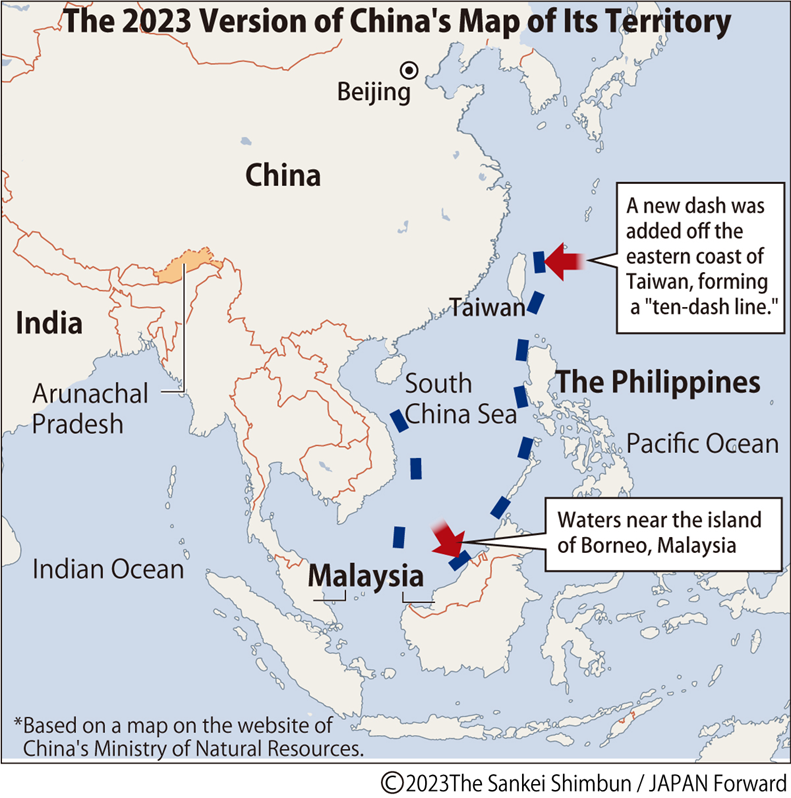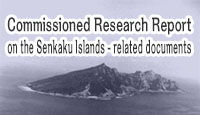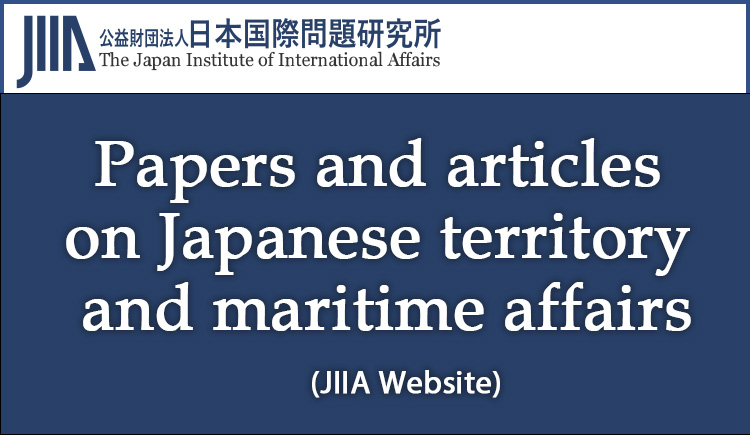The documents and materials published on this website were collected, researched, and prepared with advice from experts, as a part of a Government-commissioned project. The contents of this website do not reflect the views of the Government. Links to external sites (domains other than https://www.cas.go.jp) are not under the management of this site. For linked websites, please check with the organization/group that manages the website for the link in question.
The South China Sea and East China Sea
Column What are China’s Aims with the Ten-Dash Line in the South China Sea?
SAKAMOTO Shigeki (Professor Emeritus, Kobe University)
*Adobe Acrobat Reader DC, provided by Adobe, is needed to view the PDF files. If you do not have the software, please download it from the linked site. Adobe Acrobat Reader DC
1. Introduction
On August 28, 2023, the Ministry of Natural Resources of China issued the 2023 edition of its “Standard Map.” On this map, in addition to the previously drawn “nine-dash line” in the South China Sea, a new dash had been added to encompass Taiwan, thus creating a “ten-dash line.”1 This action by China can be read as having added a new role for the line. The line seems to suggest island attribution, in addition to its existing claims concerning historical rights to the maritime area of the South China Sea. This new dash is clearly intended to create a line that presses China’s claim of sovereignty over Taiwan. In a press conference on September 5, 2023, then Chief Cabinet Secretary MATSUNO Hirokazu stated that the Government of Japan had lodged a protest regarding the naming in the 2023 Standard Map of Uotsuri Island in the Senkaku Islands using the Chinese name of “Diaoyu Dao,” which China uses to assert its claims over the Senkaku Islands.2

The origins of the nine-dash line date back to December 1, 1947, when the Department of Territorial Administration under the Ministry of the Interior of the Republic of China compiled and published a “Comparison Table of the Old and New Names of the South China Sea Islands,” and a “Map of South China Sea Islands.” That map featured a U-shaped, 11-dashed line encompassing the Spratly and Paracel Islands and others. The People’s Republic of China also used the same line on its officially published map of 1949.
Article 2(f) of the Treaty of Peace with Japan, signed on September 8, 1951, stipulates that, “Japan renounces all right, title and claim to the Spratly Islands and to the Paracel Islands,” but prior to this, on August 15, 1951, then Premier Zhou Enlai had stated the following, “The draft stipulates that Japan renounces all rights to the Spratly and Paracel Islands, but again deliberately fails to mention the issue of restoring sovereignty over these islands. As a matter of fact, just like all the Nan Sha Islands, Chung Sha Islands and Tung Sha Islands, the Si Sha Islands (the Paracel Islands) and Nan Wei Island (Spratly Island) have always been China’s territory.”3 In light of the name of the “Map of South China Sea Islands,” and subsequent statements by the Chinese government, such as the one above, it is reasonable to interpret that in essence the nine-dash line was initially considered to be a line indicating China’s claims of ownership over the islands.
When Bach Long Vi Island in the Gulf of Tonkin was ceded by China to Vietnam in 1953, China redrew its map, removing two of the dashes to create a nine-dash line. Ever since then the line has been known as the nine-dash line. However, from now on, it would be called the ten-dash line. In any event, it goes without saying that the announcement of a ten-dash line by the Chinese government sends a strong message asserting that Taiwan is an island that is part of China’s territory.
Note 1
“People’s Daily Online” (Japanese edition), August 29, 2023, (Last viewed: January 4, 2024).
Note 2
Asahi Shimbun, September 6, 2023, morning edition, p. 14.
Note 3
Statement by Zhou Enlai concerning the US-UK Draft of the Treaty of Peace with Japan and the San Francisco Conference; Takano Yuichi, Nihon no Ryōdo [Japan’s Territory], (University of Tokyo Press, 1962), p. 339.
2. China’s moves to increase pressure on Taiwan
In his annual New Year television address delivered on December 31, 2023, in advance of the presidential election scheduled to take place in Taiwan on January 13, 2024, President Xi Jinping reiterated his resolve for unification with Taiwan, stating, “China will surely be reunified, and all Chinese on both sides of the Taiwan Strait should be bound by a common sense of purpose and share in the glory of the rejuvenation of the Chinese nation.”4 However, the result of the presidential election of January 13, 2024 confounded China’s hoped-for outcome, with Lai Ching-te of the ruling Democratic Progressive Party (DPP) being elected, a person previously criticized by China as a proponent of Taiwanese independence.5
The United States and China are fiercely opposed when it comes to the matter of Taiwan. On August 2, 2022, then Speaker of the U.S. House of Representatives Nancy Pelosi became the first sitting Speaker in 25 years to visit Taiwan, where she met with President Tsai Ing-wen. China reacted ferociously with large-scale military exercises in the sea and airspace around Taiwan from the night of August 2 to August 10, including joint blockade, sea and land attack, air superiority operation, aerial reconnaissance, and anti-submarine warfare. According to the Ministry of Defense of Japan, it is probable that in this series of military exercises, China may have rehearsed some parts of a Taiwan invasion operation, such as the blockade of Taiwan in wartime, ground/anti-ship attacks, the acquisition of sea/air superiority, and gray-zone situations, including cyberattacks and cognitive warfare.6 It is clear that China envisions a Taiwan contingency where there is an armed conflict with Taiwan.
In actual fact, at the 20th National Congress of the Communist Party of China (CPC), held from October 16 to 22, 2022, referring to China’s policy of reunification with Taiwan, President Xi Jinping emphasized that China “will never promise to renounce the use of force, and we [China] reserve the option of taking all measures necessary.”7 However, whether such measures would immediately lead to an armed invasion of Taiwan or a maritime blockade around Taiwan would likely be a decision that China would make after ascertaining the response of Japan and the U.S. to such a situation. As President Xi enters an unprecedented third term in office, it is very clear that he is seeking to make Taiwan’s reunification his political legacy, setting aside whether it can be achieved during his own term in office.8
However, the aggression against Ukraine, referred to by Russia as a “special military operation,” has now lasted for two years since it was launched on February 22, 2022, and the war remains ongoing. The current situation in which Russia has been frustrated in achieving its objectives even in Ukraine, with which it shares a land border, demonstrates that it will be no easy matter to gain control of Taiwan, an island, even with China’s military might. What is more, a maritime blockade is a measure that is acceptable only in international armed conflicts between belligerent countries. China maintains that Taiwan is a part of China and therefore even if an armed conflict were to break out between China and Taiwan, it would be a non-international armed conflict. Under international law, China could not impose a maritime blockade against third country vessels and aircraft entering or leaving Taiwan’s exclusive economic zone (EEZ) or surrounding international waters and could not attempt maritime capture of vessels and others that ignore such a blockade. If it were to push ahead regardless with such actions, it would be understood as an implicit recognition of Taiwan as a belligerent under international law, with the result that the armed conflict between the two parties would shift from being a non-international armed conflict to an international armed conflict. For China, which wants to avoid any actions that could lead to Taiwan being accorded legal status, it is not an option to engage in any actions that use the concept or wording of “maritime blockade.”9 Although Xi has stated that China will “never promise to renounce the use of force,” any such use of armed force would bring with it a whole host of difficulties, both militarily and in terms of international law.
According to recent press reports, from around the time of the previous large-scale military exercises, four PLAN frigates have been the centerpiece of a permanent deployment in the vicinity of Taiwan. It is being reported that of these four frigates, one is deployed in the vicinity of Okinawa and Yonagunijima Island, one between Yonaguni and the Philippines, and one each in the seas to the southwest and north of Taiwan.10 As a means of countering the U.S. Navy, China is strengthening its “Anti-Access/Area-Denial” (A2/AD) capabilities, and is pursuing a strategy of preventing U.S. forces from gaining access behind the so-called “First Island Chain,” and the location of the Chinese military vessels on permanent deployment matches such a strategy.
Note 4
Sankei Shimbun, December 31, 2023, (Last viewed: January 29, 2024).
Note 5
Asahi Shimbun, January 13, 2024, (Last viewed: January 29, 2024).
Note 6
“Column: Chinese Military Trends Concerning Taiwan,” Defense of Japan 2023, (Last viewed: January 29, 2024).
Note 7
Nihon Keizai Shimbun, October 16, 2022, (Last viewed: January 29, 2024).
Note 8
“Kawaru Chūgoku to no tsukiaikata” [“Changing ways of dealing with China”] (interview with former Japanese ambassador to China TARUMI Hideo), Asahi Shimbun, January 27, 2024, morning edition, p. 9.
Note 9
For further details see, MAYAMA Akira, “Chūgoku ni yoru tai-Taiwan kaijō kōtsū bōgai no kokusaihōteki kentō” [“International legal consideration of China’s obstruction of Taiwanese maritime traffic”], Kōryū, No. 986 (2023), pp. 7-16.
Note 10
Yomiuri Shimbun, January 29, 2024, (Last viewed: January 29, 2024).
3. China’s moves to step up pressure in the South China Sea
In the Coast Guard Law of the People’s Republic of China that entered into force on February 1, 2021, the area covered by coast guard-related activities is defined as: “Where a coast guard agency conducts the activities of maritime rights protection and law enforcement on and over the waters under the jurisdiction of the People's Republic of China (hereinafter referred to as the "waters under the jurisdiction of China"), this Law shall apply” (Article 3), and executive jurisdiction is exercised in the waters within the nine-dash line in the South China Sea.11 This is the cause of rising tensions with the Philippines and other countries around the South China Sea.
In particular, following the change of administration in the Philippines, when President Ferdinand Marcos Jr. took office in June 2022, replacing the Duterte administration, which had followed a conciliatory policy with China, the new President declared that the Philippines “will not lose an inch” of territory. The Enhanced Defense Cooperation Agreement (EDCA) that was originally concluded between the United States and the Philippines in 2014 has also been revised, increasing the number of bases that the U.S. military can use from five to nine. These developments have prompted China to step up countermeasures against the Philippines.
On September 26, 2023, the Philippine Coast Guard removed a 300-meter-long floating barrier placed on Scarborough Shoal in the South China Sea by the China Coast Guard and Chinese maritime militias. The Philippines is in dispute with China over the sovereignty of Scarborough Shoal, Second Thomas Shoal, and the Spratly Islands (Nansha Islands) including Whitsun Reef. The Philippines asserts that Scarborough Shoal is an “integral part of Philippine territory.”
In 1999, the Philippines deliberately grounded the old ship BRP Sierra Madre, transferred from the U.S. Navy, on Second Thomas Shoal (Philippine name: Ayungin Shoal, Chinese name: Renai Jiao) and stationed marines and other personnel there, creating a base for effective control. On February 6, 2023, a China Coast Guard vessel fired water cannons at a Philippine resupply vessel bringing supplies, and obstructed the accompanying Philippine patrol vessel by firing a laser beam at it. On April 28, another incident occurred in which a large China Coast Guard vessel came within 40 meters of a Philippine patrol vessel, almost causing a collision.
On October 22, 2023, an incident occurred in the seas around the Spratly Islands (Nansha Islands) in which a Philippine resupply vessel and China Coast Guard vessel collided, and a Philippine Coast Guard patrol vessel accompanying the military resupply vessel was bumped by a Chinese maritime militia vessel. On October 25, President Biden of the United States stated, “Any attack on the Filipino aircraft, vessels, or armed forces will invoke our Mutual Defense Treaty [EDCA] with the Philippines,” thus sending a warning to China by emphasizing the United States’ defense obligations. China’s Ministry of Foreign Affairs spokesperson Mao Ning rebuffed this statement, noting that “the United States has no right to get involved in a problem between China and the Philippines.”12
On December 3, 2023, the Philippine Coast Guard announced that more than 135 Chinese vessels, thought to be carrying Chinese militia, were anchored in the seas around the Spratly Islands, which the Philippines claims as its own EEZ. The Philippines issued an order for the vessels to withdraw, but China did not respond. China’s pressure on the Philippines is thus being stepped up in this way.
Note 11
SAKAMOTO Shigeki, “Kinō kakudai suru Chūgoku kaikei: Chūgoku kaikeihō no nerai wo saguru” [“Expanding Functions of the China Coast Guard: Exploring the Aims of the China Coast Guard Law”], in Sakamoto, Nihon no kaiyō seisaku to kaiyōhō [Japan’s Maritime Policy and Law of the Sea (3rd ed.)], (Shinzansha, 2023), p. 32.
Note 12
“Minami shina kai de no senpaku shōtotsu Firipin to Chūgoku tagai ni kōgi, tairitsu fukamaru” [“Confrontation Deepens as Vessels Clash in South China Sea, China and the Philippines Both Issue Protests”], (Last viewed: January 29, 2024).
4. China’s persistence in ignoring the Award in the South China Sea Arbitration Case
In the South China Sea Arbitration Case in which the Philippines pursued a claim against China on the grounds that China’s claims based on the nine-dash line in the South China Sea are contrary to the UN Convention on the Law of the Sea (UNCLOS) and therefore without lawful effect, in July 2016 the Tribunal issued its award, finding that “China has unlawfully prevented Philippine fishermen from pursuing their livelihoods by interfering with traditional fishing activities at Scarborough Shoal,” and that “China has breached its obligations under the Convention by operating its law enforcement vessels in a dangerous manner causing serious risk of collision to Philippine vessels navigating in the vicinity of Scarborough Shoal.” In addition, it was also ruled that, “China has unlawfully aggravated and extended the dispute by, among other things: (a) interfering with the Philippines’ rights of navigation in the waters at, and adjacent to, Second Thomas Shoal; (b) preventing the rotation and resupply of Philippine personnel stationed at Second Thomas Shoal; and (c) endangering the health and well-being of Philippine personnel stationed at Second Thomas Shoal.”13 Regardless of this award, China has ignored the rulings contained therein and continued its effective control over the reefs and shoals of the Spratly Islands.
In response to an application submitted by Malaysia to the Commission on the Limits of the Continental Shelf (CLCS) dated December 12, 2019, concerning the extension of its continental shelf, China lodged an objection, once again reiterating its own self-serving claims in the forum of the United Nations. In a Note Verbale to the Secretary-General of the United Nations dated June 2, 2020, it was stated that, “China has historic rights in the South China Sea. China’s sovereignty over Nanhai Zhudao and its maritime rights and interests in the South China Sea are established in the long course of historical practice and consistent with international law, including the Charter of the United Nations and the United Nations Convention on the Law of the Sea (UNCLOS)” (Para. 1). The same Note Verbale went as far as to state that, “The Arbitral Tribunal exercises jurisdiction ultra vires, clearly errs in ascertaining facts and applying the law. The conduct of the Arbitral Tribunal and its awards…gravely infringe China’s legitimate rights as a sovereign State and a State Party to UNCLOS, and thus are unjust and unlawful. The Chinese Government has solemnly declared that China neither accepts nor participates in the South China Sea arbitration, and neither accepts nor recognizes the awards. This position is consistent with international law” (Para. 3).14 Needless to say, this position was opposed by other countries.
In a Note Verbale addressed to the UN Secretary-General from the Permanent Mission of Indonesia to the United Nations dated May 26, 2020, China’s position is rebutted in a paragraph that states, “Indonesia reiterates that the Nine-Dash Line map implying historic rights claim clearly lacks international legal basis and is tantamount to upset UNCLOS 1982.15” Similarly, in a Note Verbale dated August 3, 2021, New Zealand also rejected China’s claims, stating, “There is no legal basis for states to claim ‘historic rights’ with respect to maritime areas in the South China Sea, as confirmed in the 2016 South China Sea Arbitral Award.”16 As can be seen by these rebuttals by multiple countries, it is not the South China Sea Arbitration Case award that is mistaken, but rather the stance taken by China.
Note 13
Award of the South China Sea Arbitration Case, July 12, 2016, pp.12-14, para. 31 and pp.17-19, para. 41.
Note 14
Note Verbale dated 2 June 2020 from the Permanent Mission of the People’s Republic of China to the United Nations addressed to the Secretary-General of the United Nations, CML/46/2020.
Note 15
Note Verbale dated 26 May 2020 from the Permanent Mission of Indonesia to the United Nations addressed to the Secretary-General of the United Nations, CML/46/2020.
Note 16
Note Verbale dated 3 August 2021 from the Permanent Mission of New Zealand to the United Nations addressed to the Secretary-General of the United Nations, Note Verbale No. 08/21/02.
5. Conclusion
Recent actions in the South China Sea by China, a maritime superpower, seek to change the status quo by force, backed by its military might and maritime police agencies. Considering China’s stance that the Senkaku Islands are a group of islands attributed to Taiwan, a contingency in Taiwan could lead to a similar situation in the Senkaku Islands. What is already happening in the South China Sea could all too easily occur in the East China Sea.
On November 23, 2013, China established an Air Defense Identification Zone (ADIZ) over the East China Sea, including the Senkaku Islands. An ADIZ is airspace that each country establishes outside of its own territorial airspace to prevent incursions on territorial airspace. Aircraft in the ADIZ are identified to determine whether they are likely to invade territorial airspace and whether fighter jets need to be scrambled. It is believed that it was the Xi Jinping administration that revised the scope of the ADIZ originally planned by a division of the People’s Liberation Army, expanding its scope closer to the coast of Kyushu.17 According to recent reports, China has more than three military vessels permanently deployed around the borders of the ADIZ.18 A member of Japan’s Self-Defense Force (SDF) is of the view that, “in a situation such as a Taiwan contingency, China would be prepared to obstruct the advance of SDF and U.S. military aircraft.” Any contingency in Taiwan would create a similar contingency for the Senkaku Islands, meaning that Japan cannot afford to be complacent.
Note 17
Asahi Shimbun, January 12, 2014, morning edition, p. 1.
Note 18
Yomiuri Shimbun, January 28, 2024, (Last viewed: January 29, 2024).
Senkaku Islands
Research and Commentary Site
- I Comprehensive issues
- II Commentary on themes by historical period
- III Analysis of claims by other countries
- IV The South China Sea and East China Sea





